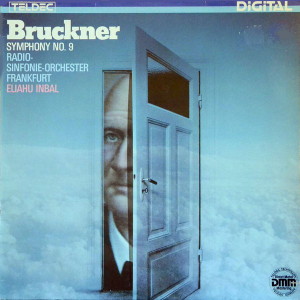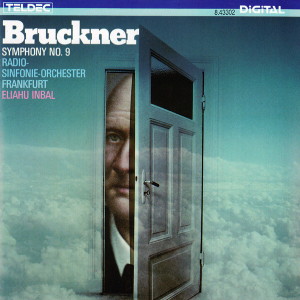 |
|
1 LP -
6.43302 AZ - (p) 1987
|
 |
| 1 CD -
8.43302 ZK - (p) 1987 |
|
| ANTON BRUCKNER
(1824-1896) |
|
|
|
|
|
| Symphonie
Nr. 9 d-moll - Originalfassung |
57'
10"
|
|
| -
Feierlich, misterioso |
23' 05" |
|
| -
Scherzo: Bewegt, lebhaft - Trio:
Schnell |
10' 24" |
|
| -
Adagio: Langsam, feierlich |
23' 41" |
|
|
|
|
| Radio-Sinfonie-Orchester
Frankfurt |
|
| Elihau Inbal,
Leitung |
|
|
|
|
|
Luogo
e data di registrazione |
|
Frankfurt
(Germania) - settembre 1986 &
ottobre 1987
|
|
|
Registrazione:
live / studio |
|
studio |
|
|
Producer /
Engineer |
|
- |
|
|
Prima Edizione LP |
|
Teldec
- 6.43302 AZ - (1 LP) - durata 57'
10" - (p) 1987 - Digitale |
|
|
Prima Edizione CD |
|
Teldec
- 8.43302 ZK - (1 CD) - durata 57'
10" - (p) 1987 - DDD |
|
|
Note |
|
Co-Produktion
mit dem HR, Franfurt.
|
|
|
|
|
Bruckner
started work
on the draft of his Ninth
Symphony on 21st September
1887, immediately after
completing the first version
of the Symphony no. 8. But
it was not until 1891, when
he retired from his
professor’s post at the
Vienna Conservatoire, that
he was able to devote his
full attention to the new
symphony. Work on the Ninth
became a race with death,
and despite Bruckner’s
exertions the symphony
remained a torso. The finale
never advanced beyond the
rough draft stage. Shortly
before his death, Bruckner
had expressed the wish
that his “Te Deum” be played
at performances of the Ninth
in place of the last
movement. Conductors have
only followed the composer’s
suggestion to a limited
extent, however, on account
of the difference in style.
The opening of Bruckner’s
Ninth Symphony grows
gradually out of a scarcely
audible whisper. Eight horns
hesitatingly explore the
harmonic field before
sounding a solemn fanfare.
After expansive modulations
in triple forte the main
theme makes its appearance:
an elemental outbreak of
pent-up energy which then
crashes to the ground in
abrupt octaves. The broad,
flowing strings melody of
the second subject, the
melodic and harmonic wonders
there of and the third
thematic group that returns
to D minor all provide
contrast in a movement
ending as it were in an open
question in the coda (empty
fifths).
As in its predecessor, in
the Ninth Symphony Bruckner
moves the scherzo to second
place. Chasms open up in
this ghostly movement, in
which the tonal perspective
is permanently at a slant.
Obstinate accompanying
chords on the strings give
the development a menacing
tension, while string
pizzicati that scurry past
give the movement an unreal,
spooky atmosphere.
After the scherzo,
the adagio has the effect of
a farewell to the earthly
world. With this movement in
particular Bruckner stands
on the threshold of the 20th
century. Not until the
seventh bar of the main
subject does the key of E
major break through in
radiant glory. As if the
music was trying to throw
off all earthly ties, after
the jump of a ninth the
subject is heard here,
soaring up more and more
ardently. Bruckner himself
wanted the descending sixth
chords of the tubas and
horns in the second subject
to be interpreted as a
“farewell to life”. At the
end of the movement the
opening motif from the
adagio of the Eighth
Symphony and the main
subject of the Seventh
Symphony are heard once
more. Thus the adagio of the
Ninth already has a certain
finale character about it.
More than six years after
Bruckner’s death, the Ninth
Symphony was given its first
performance on 11th February
1903 in Vienna’s
Musikvereinssaal. The
performance under the baton
of Ferdinand Löwe
was a resounding success. On
this occasion, however, the
symphony was played in
Ferdinand Löwe’s
own radical revised version,
which took its cue from the
orchestral sound of Wagner.
It was this version that was
printed in the same year,
and soon conducted by
Richard Strauss, among
others. The musical world
had to wait almost thirty
years before Alfred Orel’s
new edition gave it the
chance to experience the
Ninth Symphony in its
authentic form. At a concert
in Munich, Sigmund von
Hausegger presented the two
versions of the work
side-byside before an
invited audience. 36 years
after the composer’s death,
the starting signal for the
victory of Bruckner’s
original version was finally
given.
Hans
Christoph Worbs
Translation:
C. R. Williams
|
|
|